
For almost 200 years, archaeologists, art historians, and philologists have tried in vain to find a plausible explanation for the unique and well-hidden rock sanctuary of Yazılıkaya, adjacent to the former Hittite capital Ḫattuša in central Turkey. Both the ruins of the city and the sanctuary with its many reliefs carved into the natural stone have been listed as UNESCO World Heritage Sites since 1986. They are the impressive remnants of a once powerful kingdom that ruled over Central Anatolia from around 1650 to 1190 BC, and whose kings were at times on a par with the mighty pharaohs of New Kingdom Egypt.
In June 2021, for the first time, an international team comprised of archaeologists, astronomers, and ancient historians have advanced a plausible explanation for the meaning of each of the more than 90 artistically carved reliefs of mythical figures and anthropomorphic deities, documented in detail in the Journal of Skyscape Archaeology. In short, they posit that the rock sanctuary symbolizes the cosmos as the Hittites imagined it. They suggest that the reliefs illustrate the three main elements of cosmic order: the earth, the sky, and the underworld. They show how these levels, and thus all portions of the cosmos, were populated by deities. In the Ancient Near Eastern belief system, the cosmic order was stabilized through constant renewal, with celestial regularities setting the pace. Renewal occurs when after a dark and cold night the sun rises to bring a bright and warm day; when from a dark moon a full moon gradually waxes; and when the withering away of vegetation and the inhospitable winter months are succeeded by blooming plant cover of spring and summer. Yazılıkaya reflects these cosmic cycles so systematically that the sanctuary can still be used as an accurate calendar.
_________________________________
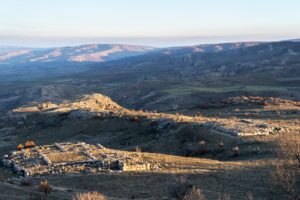
The ancient remains of Hattuša. The foundations of Temple 3 (foreground left), Temple 2 (right), and the king’s palace at Büyükkale (background) catch the first rays of the rising sun on the day of the winter solstice
2018 in the upper city of Hattuša (© Luwian Studies #1015).
_________________________________
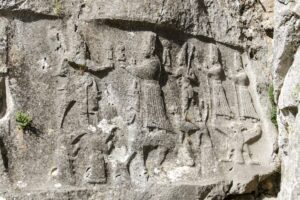
The main scene in Yazılıkaya’s Chamber A is where the processions of deities coming from
the left and from the right meet on the local meridian (© Luwian Studies #1216).
_________________________________
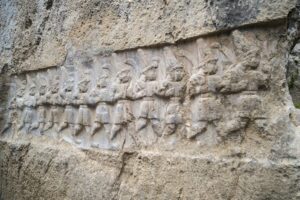
Twelve identical male gods in Chamber B carrying sickle-shaped swords (© Luwian Studies
#1233).
_________________________________
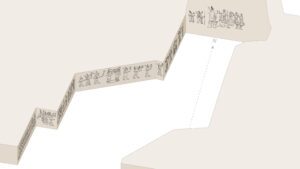
Schematic drawing of the reliefs of deities on the western wall and main panel in Yazılıkaya’s
Chamber A (© Luwian Studies #1404).
_________________________________
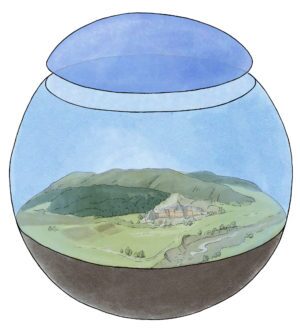
The four elements of the Hittite cosmos as symbolically depicted in the rock sanctuary of Yazılıkaya: underworld, earth, sky, and celestial circumpolar zone (© Luwian Studies #1418).
_________________________________
Egyptian Connotations
Some components of the sanctuary can be traced back to Sumerian and Old Babylonian traditions. The procession of the deities on the western wall, for instance, shows a clear hierarchical order in which the higher-ranking gods are identified with their names – some of which are Babylonian – written in Luwian hieroglyphics. This is a rare example of this script being used to express another language, namely Hurrian. Appropriations from neighboring cultures are obvious: the Luwian (Western Anatolian) writing system, the Hurrian language, and the Babylonian deities mixed in with those from the Old Anatolian tradition.
However, thus far, little attention has been paid to borrowings from Egypt, which are also frequent. The entire Luwian hieroglyphic system arose long after the Egyptian script and contains some signs from the Egyptian repertoire. The symbol of the winged sun disk, for example, is the epitome of Egyptian iconography. One relief in Yazılıkaya shows how the Hittite great king is embraced by his protective deity Šarruma – a scene known from two Hittite seals but that also reflects a longstanding Egyptian tradition. In Yazılıkaya, the days of the lunar months are depicted as individual deities in a way that reflects earlier and later Egyptian temple decorations.
What is completely new in the recently presented model is the interpretation of the main panel as a reference to the northern circumpolar region of the night sky. Constellations in this part of the sky dome never disappear below the horizon, and were thus considered undying. According to several ancient belief systems, the world axis (axis mundi) holding the cosmos together is fixed to the northern sky. In Egypt, people believed that the deceased king’s ba (or soul) traveled to this part of the cosmos after the king had first accompanied the sun god Ra on his twelve-hour journey through the underworld. Much like the walls of Egyptian temples, the reliefs in Yazılıkaya were apparently originally painted in bright colors. An Egyptian-style winged sun disk appears over the head of the Sun god of the heavens; and in a large relief of this deity in an artificially constructed chamber in Ḫattuša, the god is holding a sign that corresponds to the Egyptian key of life (ankh). The lower half of an Egyptian-style pyramid forms a large architectural complex in the highest part of Ḫattuša. This complex even contains a straight vaulted tunnel that is strictly oriented to the north and inclined upward, reinforcing the connection to the northern sky as well as the association with the axis mundi. The meridian obviously assumed a prominent meaning in Hittite cosmovision.
How are these allusions to Egyptian iconography explained? The Yazılıkaya sanctuary in its current form dates to around 1230 BC, though it had predecessors. The natural adytum was sealed off from the surroundings by temple buildings, and these reveal at least three different construction phases. At the time the present sanctuary was built, in the second half of the thirteenth century BC, the royal houses of Egypt and Hatti enjoyed exceptionally close relations. After the Battle of Kadesh (1274 BC) a peace treaty was signed (in 1259 BC) bringing the two royal houses closer together. The relations were so intimate that Pharaoh Ramses II requested from the great king of Hatti, Hattušili III, and his wife, queen Puduḫepa (the most famous, and also the last known, Hittite queen), one of their daughters to become his bride. The Hittite princess Sauškanu was then sent off to the Nile, with her mother accompanying her all the way to the Egyptian border. In December 1246 BC, the princess married the pharaoh, and she was renamed Maathorneferure (“One who sees Horus, the invisible splendor of Ra”).
________________________________

Astronomical ceiling of tomb KV17 of Pharaoh Seti I, reflecting the northern night sky (©
Luwian Studies #5024).
________________________________

Star trails above Yerkapı emphasize the strict northern orientation of the architecture (©
Bernd Pröschold/Luwian Studies #1041).
________________________________
Puduḫepa’s Signature
A few years after the wedding, the princess received her brother Hišmišarruma as a formal visitor in the Egyptian capital Per-Ramesses, in the eastern Nile Delta. The Hittite prince decided to remain through the winter in the region. Yazılıkaya obtained its current form only a few years after this visit. The references to Egyptian iconography could thus well be based on impressions (and perhaps even records) gathered during a period of close family ties between the royal courts. Back in Ḫattuša, Hišmišarruma would have reported in detail about his impressions of the Egyptian court. His brother Tašmišarruma was in line to succeed the king – and Yazılıkaya indeed contains two prominent reliefs of him, dating to the time when he ruled under the name Tudḫaliya (IV). After he had taken the throne, the new king was further advised on questions of religion by his mother Puduḫepa. The sanctuary in its present form thus bears Puduḫepa’s handwriting. Puduḫepa was born at the beginning of the thirteenth century BC in the city of Lawazantiya in Kizzuwatna as the daughter of the chief priest of the city’s patron deity, Ištar; and so Puduḫepa grew into the role of a priestess of the same goddess. About a year after the Battle of Kadesh, the Hittite general Hattušili met Puduḫepa, who was then perhaps only fifteen years old, and took her as his wife. Hattušili eventually usurped the Hittite throne from his nephew Muršili III, and so Puduḫepa became queen. As a priestess, she worked on the organization and rationalization of the Hittite religion. The last phase of these syncretizations was immortalized in Yazılıkaya.
_______________________________
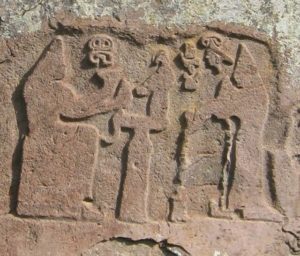
Ancient relief carving showing Queen Puduhepa on the right. Krähenstein, Creative Commons Attribution-Share Alike 3.0 Unported license, Wikimedia Commons
_______________________________

Letter of Friendship written in Akkadian by Naptera, the wife of Ramses II, the king of Egypt, to Puduhepa, the wife of Hattusili III, the King of Hittites, between the years of 1275-1250 BCE. Isabeau, Creative Commons Attribution-Share Alike 4.0 International license, Wikimedia Commons
_______________________________
The Hittite Demise
Around 1190 BC, the sanctuary was abandoned along with the capital. The influence and power of the great Hittite kings had declined over the course of a few generations, primarily owing to disputes within the royal family. The neighboring states of the Hittite kingdom took advantage of the weakness of the central power and from all four sides pushed the border ever further toward the capital. With their constant raids, the Kaška had always dominated the northern border, thereby preventing Hittite access to the Black Sea. Assyrian forces stormed forward to the east, conquering extensive areas including the valuable copper mines of Išuwa. Tarḫuntašša in the south had been a loyal vassal for generations, but even that state appears to have fallen away from the central government and then may have challenged it. In the west, everything depended on whether the small states based there would decide to join forces (against the great king). It was precisely during this fragile time that the so-called Sea Peoples suddenly attacked the coast of Cyprus, an island that the Hittite great king had annexed not long before. Then Ugarit in northern Syria, the last loyal vassal of the Hittite royal house, fell victim to the raids of the Sea Peoples, and Hittite forces found themselves involved in both sea and land battles. Soon after, the ruling class abandoned the capital, taking most movable objects with them or hiding them. The Hittites left most rooms swept clean. As a result, archaeological excavations brought few significant artifacts to light – apart from the extensive archives.
Rediscovery
We know nothing about the fate of the sanctuary between 1190 BC and AD 1834, when, at last, the French archaeologist Charles Texier explored the area in search of forgotten historical cities. Local farmers led him to the hidden shrine, and then he spent time there making sketches to illustrate his discovery. Upon his return to Paris, Texier’s account caused quite a stir among the bourgeoisie, partly because his drawings of the reliefs were grossly exaggerated. Yet that would not have been necessary, because there is no question that Yazılıkaya is a very special place. In the wake of Texier’s report, a number of scholars visited the area in the nineteenth century. They returned with more drawings exhibiting increasing accuracy, including some of the earliest photos.
It would be futile to ruminate on the initial attempts at interpreting the meaning and function of the shrine, which are far-fetched from today’s perspective. It is much more interesting to review the individual aspects that were recognized at an early stage and which have now been confirmed by the latest research. One of the first European visitors to the shrine observed that “those figures furthest removed from the center were perhaps being intended for inferior persons” (Hamilton 1842, 384). The two bull-men in the center of the western procession “appear to carry a barque” (von Ritter 1858, 386), which undoubtedly symbolically indicates a solar eclipse (Barth 1859, 136). Today we know that the symbol resembles the “boat of light” and that it marks the only day of the month on which a lunar eclipse may occur. Some iconographic elements, including the winged sun disk, seem to be derived from Egypt (von Ritter 1858, 392). “The chief figures are represented larger than the rest which is in accordance with Assyrian and Egyptian custom” (van Lennep 1870, 119). The hieroglyphic symbols correspond to those found in Hama and ought to be attributed to the Hittites: “And [they] must be assigned a much higher antiquity than has hitherto been supposed,” namely 1200 BC (Tozer 1881, 77–78). Many of the figures are provided with hieroglyphics in the form of ellipses with a vertical central line, marking them as deities (Belck 1901, 477). Therefore, the two largest figures must be the main deities, while the relief opposite them shows the Hittite ruler (Belck 1901, 478). Large boulders in front of the chambers belong to the foundations of temple buildings (Belck 1901, 480). John Garstang (1929, 105, Plate 24) suggested counting the figures on the west wall from center to left, which would be appropriate from today’s perspective. Garstang (1929, 97) said of the main deity: “We have here an illustration of the familiar convention, seen also in Egyptian drawing.” Kurt Bittel, excavator of Ḫattuša and Yazılıkaya from 1931 to 1977, interpreted the Hittite spring sanctuary of Eflatunpınar near Lake Beyşehir in central Anatolia as a representation of the cosmos (Bittel 1941, 63), but did not apply this notion to Yazılıkaya. The male deities at the left end of the procession on the west wall of Chamber A can be associated with the deities for the months (Cornelius 1973, 260, 345n34), and a comprehensive cosmological interpretation for Yazılıkaya was put forward by the astronomer E. C. Krupp (1997a; 1997b; 2000; 2005), who also took part in the latest inquiry. References to a deliberate astronomical orientation of the temples in front of the sanctuary can be found from 2000 onward (Belmonte 2000, 89). Prehistorian Jürgen Seeher was the first to mention that the large relief of Tudḫaliya in Chamber A only receives sunlight during the days around the summer solstice (Seeher 2011a, 85; 2011b, 157).
The most recent discoveries that the deities in Chamber A could be used to operate and display a lunisolar calendar (Zangger and Gautschy 2019) and that the sanctuary as a whole symbolized the cosmos with its levels and celestial regularities (Zangger et al. 2021) developed seamlessly from a long line of previous research. Rather than being considered as marking the end of a quest that spanned almost two centuries, they should be used as a tool to a better understanding of the Hittite religion – one that includes celestial aspects.
_______________________________

Main panel in Chamber A (Reliefs 42–46) showing the chief deities Teššub and Ḫebat (©
Luwian Studies#1217).
_______________________________
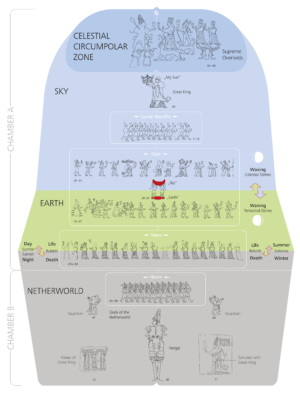
Proposal for the cosmological model depicted in Yazılıkaya, including all reliefs of deities and emphasizing the groups they form and how these are related to each other to symbolize recurring celestial cycles (© Luwian Studies; #1419).
_______________________________
Scientific publication (Open Access)
Zangger, Eberhard, E. C. Krupp, Serkan Demirel and Rita Gautschy (2021): “Celestial Aspects of Hittite Religion, Part 2: Cosmic Symbolism at Yazılıkaya.” Journal of Skyscape Archaeology 7 (1).
_______________________________




